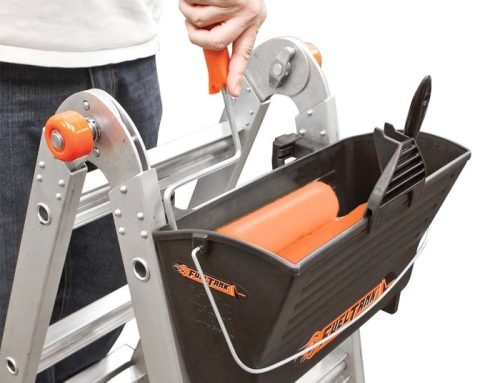Doing roof maintenance and repairs is beyond the skills of many homeowners, and usually  these tasks are done by professional roofers (and they probably do their own work at home as well). Hiring a professional to repair broken tiles or carry out more major work is your best bet if you are not trained to do it yourself, but even with all the training given to professional roofers there is still a risk involved in working at these heights, especially on sloping surfaces.
these tasks are done by professional roofers (and they probably do their own work at home as well). Hiring a professional to repair broken tiles or carry out more major work is your best bet if you are not trained to do it yourself, but even with all the training given to professional roofers there is still a risk involved in working at these heights, especially on sloping surfaces.
One roofer from Lynchburg, Virginia, invented a safety device to help secure roofers to the roof surface and enable them to attach a safety harness and ladder to an immoveable anchor point. The Slator is a metal device the same shape as an ice-scraper, which attaches to a slate or asphalt shingle roof with six bolts. The device can take a load of around 5,000 lbs, which is more than the average small car. The worker can attach his ladder and safety harness independently to the Slator, and if either should fall then there is no risk of the worker falling to the ground as well.
Ronny Roseveare, the inventor of the Slator, has also come up with a solution to the problem of drilling six holes into a roof in order to attach the Slator. The Bibby is a thin metal sheet that can be fixed into place over the holes using roofing caulk, and it can also be hidden underneath tiles, plugging the gaps invisibly.
Smaller roofing firms may not use harnesses, and Roseveare has witnessed several roofers working unattached to any safety device. However, larger firms who may be more liable for compensation claims are taking up the device as a way to prevent work-related accidents; in 2013 the greatest cause of workplace deaths in the USA was falls during a construction project, so anything that can reduce this number is surely a good thing.
Many roofers already use roof ladders with a hook at the top designed to secure the ladder to the roof, and some also use roof boards to climb up and down the surface once they are already up there. However, roof hooks are not much use on curved rooftops or steep roofs such as churc h steeples and some modern builds, so the Slator really comes into its own in these situations. Attaching a safety harness to a roof that is need of repair is not a good idea, as the surface may not be able to take the weight. The Slator attaches to the roof into the structure of the roof itself, so it provides a much more secure anchor point on which to attach a harness and ladder.
h steeples and some modern builds, so the Slator really comes into its own in these situations. Attaching a safety harness to a roof that is need of repair is not a good idea, as the surface may not be able to take the weight. The Slator attaches to the roof into the structure of the roof itself, so it provides a much more secure anchor point on which to attach a harness and ladder.
The success of the business remains to be seen; Roseveare has invested his own money into patenting and approving the device with the American authorities, and the device is manufactured locally rather than overseas, where costs may be lower. Slator LLC hopes to see profit in the next few years, and business is already looking good with the company able to advertise in trade publications and sales already happening across nine states. Word of mouth and further advertising should help this small business get off the ground, but Roseveare is in no hurry to change careers and become a manufacturer full time, as he enjoys his roofing job. He will be able to enjoy it a lot more now though, knowing he is fully protected from falls thanks to his invention.






Leave A Comment
You must be logged in to post a comment.